MK Diary
DAY 1
10 July 2023 Monday
Sunny afternoon
Top of 33 degrees
We left Matsushima at 11 am, after visiting the Zuigan-ji, Sankei-den inside the Entsu-in and the Tenrin-in temples. We drove through Sendai, stopped for lunch at Michinoku Centre by Kamafusa Lake at midday on National Highway 286 in Kawasaki. We arrived in Togatta Onsen just before 1 pm.
We parked in the free car park outside the town Kattamine Shrine. The Founder and Director of the Togatta Maruyoshi Artists’ Residency, Satoh Masanori (44) met us and took us to our lodging and studio, a former fish shop between an izakaya Mikoshi and a soba shop, Shoan, across the street from the Togatta Event Park.

Togatta Maruyoshi Artist Residence between an izakaya Mikoshi and a soba shop, Shoan. Photo Mayu Kanamori
After meeting Intan Anggita Pratiwie (36), an Indonesian recycling artist and a sustainable fashion researcher, another artist in residence, we went for a short walk around town. We first visited Ozeki-ya, an antique kokeshi doll shop, then walked past a butcher, a souvenir shop, a liquor shop, two tofu shops, two public onsens, more than a dozen eateries and four ryokans; there were more hotels we could see in the distance.
We walked to Matsu-kawa River and the Kokeshi-bashi Bridge, then turned back, walking along the western side of the town. We passed a police station, a grocery shop, a taxi depot, and a Seven-Eleven convenience store. We soaked our feet in an ashiyu, a public foot bath, between the public bath Kami-no-yu and the Zao-machi Town Tourist Information Centre.
Satoh-san returned about 5 pm and took me to visit Kimura Yoko-san at the Kimura Shoten, a liquor store that sells local sake, shochu, souvenirs and more. Kimura-san is the organiser of the local tanka club. She said that the club members met every four months or so with a teacher from Sendai. I explained our project to her. She thought that their members were getting too old to become involved in an arts project.
She questioned whether utamakura poetry places can be created, because they are places that already exist, and cited Sue-no-matsuyama, two pine trees on top of a hill in Tagajo City, and sung by many, including 10th century Heian poet, Fujiwara no Okikaza (dates unknown) in the early Heian Period, Kiyohara no Motosuke (908−990) and Matsuo Basho (1644–1694).
I bought a bottle of Zao sake called Natsu no Hi for Martin and went back to our studio residence.
At 6 pm we ate dinner next door at Mikoshi. On our way to the bathhouse, on the street, we met Nagai Kyoka-san (26), who works with Satoh-san. She had visited us earlier to introduce herself and to discuss visiting Shiroishi together. Nagai-san is from Shiroishi and lives there.
We were too late for the public bath, Kami-no-yu, so Nagai-san took us across the street to meet the owners of Genbei, a ryokan with a bath we could use. Satoh-san had previously mentioned that Maruyoshi had an arrangement with this inn.
We turned our lights off just after 8pm.
DAY 2
11 July 2023
Mostly cloudy, some rain
Top of 29 degrees
After a light breakfast from the convenience store across the road, we walked to the Kokeshi-bashi Bridge again. This 91-meter long and 7.8-meter-wide bridge, part of National Highway 457, runs over the Matsu-kawa River. On both sides and ends of the Kokeshi-bashi Bridge are metal three-meter-high kokeshi dolls, made in 1971. Kokeshi are wooden dolls from the Tohoku region of Japan, and Togatta has its own style of kokeshi dolls.
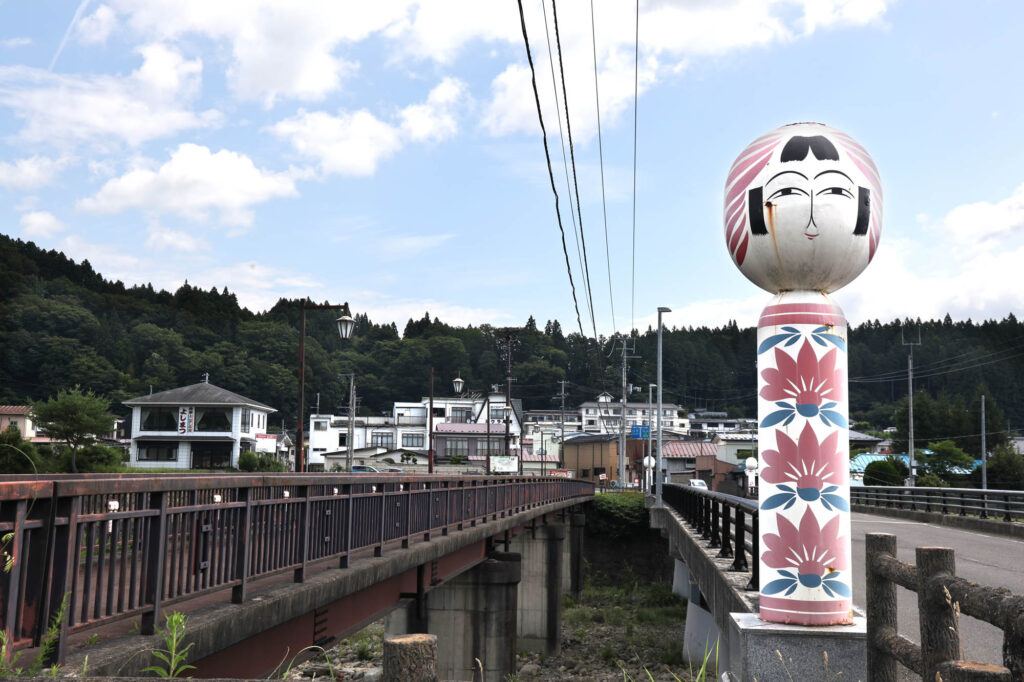
Kokeshi-bashi Bridge with Togatta Onsen in the background. Photo by Mayu Kanamori
From the bridge towards the west, we could see the Zao Mountain Ranges and a smaller mountain in the southeast. The names of these mountains were written on the wall of the Tourist Information Centre, and further explained by Onuma-san, who was working there. The mountains from left to right (south to north) are: Fubou-san (1705 meters), Minami, Byobu-dake (1810 meters), Byobu-dake (1825 meters), Ushiroeboshi-dake (1686 meters), Katta-dake (1758 meters), Kumano-dake (1841 meters) and Myogobo (1491 meters). In the southeast, we saw the Aoso-san (799 meters).
At 11 am we ordered lunch from Mikoshi next door, which delivered our oyako-don. At half past 11, Ozeki Sadanori-san (73) from the Ozeki-ya Antique Kokeshi Shop visited our studio to let us know that he saw a New Zealand cyclist, Paul Imperatrice, who is travelling around Japan on his bicycle on television last night. Satoh-san came shortly after to apologise for not bringing an extra futon last night and said that he would deliver it later in the afternoon.
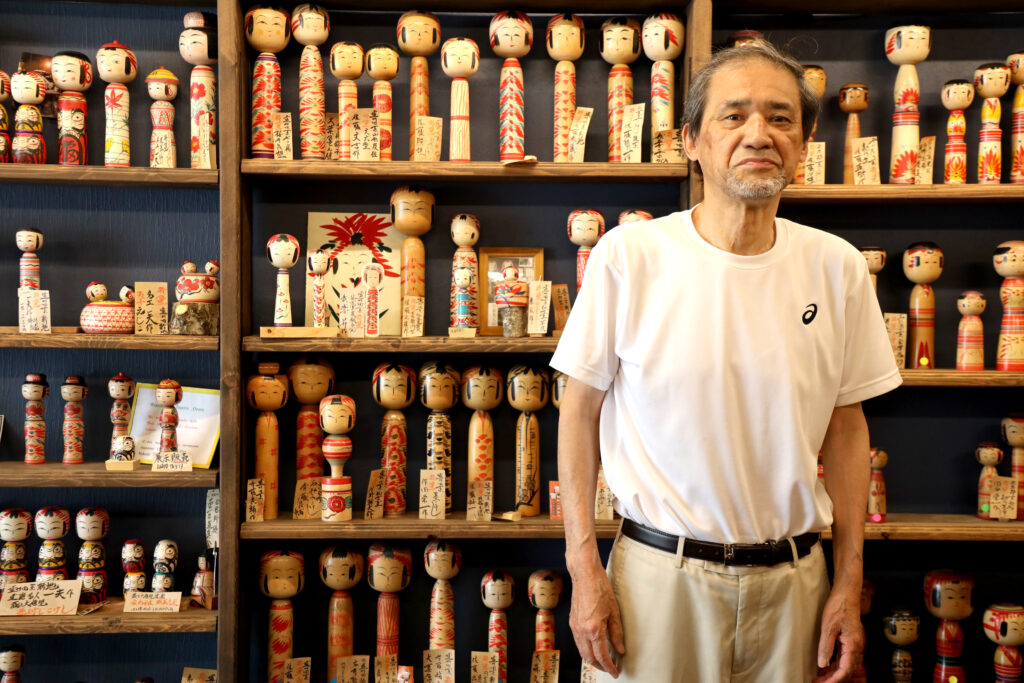
Ozeki Sadanori-san from the Ozeki-ya Antique Kokeshi Shop. Photo by Mayu Kanamori
Just before 1 pm, I went for a short walk and went into a second-hand clothing and antique shop E-link and met Watanabe Takashi-san who was minding the shop. When I walked out of his shop, it began to rain. I went to Ono Shoten, where I met Ono-san and her husband, who said he painted in oils. He said that their shop supplied the ryokans, so if I don’t see what I want, I should ask, since they have most things out the back. I bought two peaches. When I left the shop, the rain had stopped.
Martin ate his peach and went for a walk to the town Kattamine Shrine but returned soon after. He said he would wait for me to go up to the shrine. Martin continued to work in the back room where he set up his computer yesterday. I set up my computer in the front room with the full shopfront so I can watch people go past in the street.
Watanabe-san came to visit after his work at 4 pm. He said he is originally from Fukushima and now lives in Sendai. He drives to Togatta every day. He manages the entire Zao Patio complex which has the E-link, the second-hand clothing and antique shop he was managing, a bakery and a fruit parlour.
Just before 5 pm, I went out to photograph the Kokeshi-bashi Bridge again, where I met two cyclists, Agnes and Antoine from Germany and France, respectively, who are travelling around Japan on their bicycles, and were planning to camp in Togatta for the night. They had cycled across the Zao Range from Yamagata and were on their way to Sendai. Agnes is an artist and was interested in the residency, so they visited our studio. They both agreed to contribute poems for our residency project.
Satoh-san visited with his two friends, and Martin and I went to the town Kattamine Shrine to pay our respects. There is a shrine of the same name on the summit of Katta-dake Mountain called Kattamine Shrine Okumiya (奥宮) and the one in town is called Kattamine Shrine Satomiya (里宮). The deity is moved seasonally between the two shrines, to the Okumiya on the summit in the summer and to the Satomiya at the foot of the mountain in the winter.
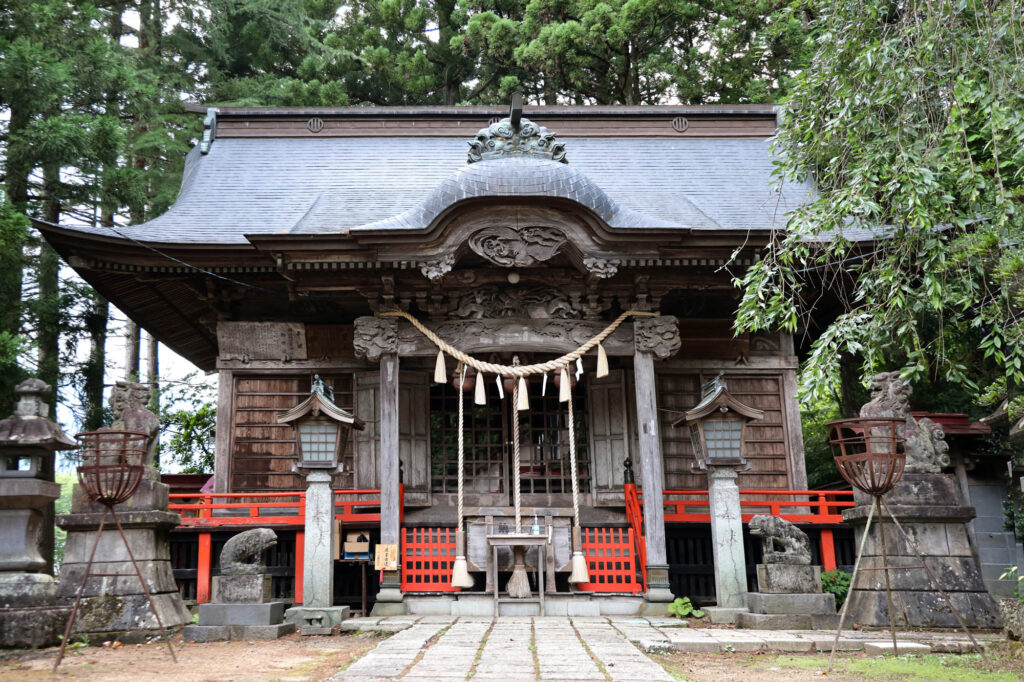
Town Kattamine Shrine (Satomiya). Photo by Mayu Kanamori
We soaked our feet in the ashiyu again, then visited the public onsen, Kami-no-yu, before eating dinner at a different izakaya, Yakata.
We turned off the light near 9 pm.
DAY 3
12 July 2023 Wednesday
Cloudy
Top of 33 degrees
After another breakfast from the convenience store across the road, we spent most of the morning in the studio writing. Satoh-san visited to see how we were. He told us about a knowledgeable woman who works at the Kokeshi Museum. He said she will be back at her work on the 19th.
We had our lunch at Cafe Enso, whose owner Endo Yuichiro-san (75) was born in Togatta, and after spending his middle and high school days in Sendai, returned to look after his parents and take over their restaurant. His son Soichiro-san (47) was the chef in the kitchen.
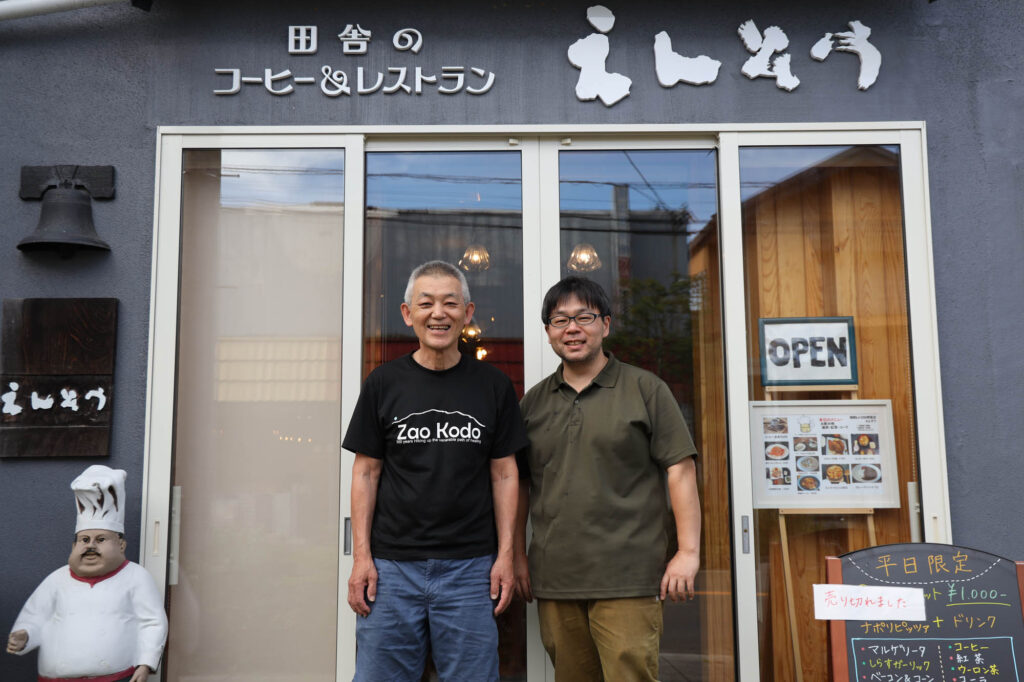
Endo Yuichiro (75) and his son Soichiro (47) at Café Enso. Photo by Mayu Kanamori
Yuichiro is part of Zao Kodo no Kai, a group who restored the Zao Kodo, the old pilgrim’s road that connects the Kattamine Satomiya, the town shrine to the Kattamine Okumiya, which stands on the top of Katta-dake Mountain, the third highest of the eight mountains on the Zao Range. Since the Zao Echo Line opened in 1962, allowing pilgrims and tourists to visit the top of Katta-dake by car, people stopped using the old walking track. Yuichiro explained that ten years ago, with advice from two Elders who remembered the old road, he and his friends cut grass, stomped on the old road and revived it as a hiking track. He said now his mission is to pass on this knowledge to the younger generation, and his group now has 300 members. The group takes bookings as mountain guides to climb this 15 km road, which takes 390 minutes. Their brochure said that the return trip will take 45 minutes by car.
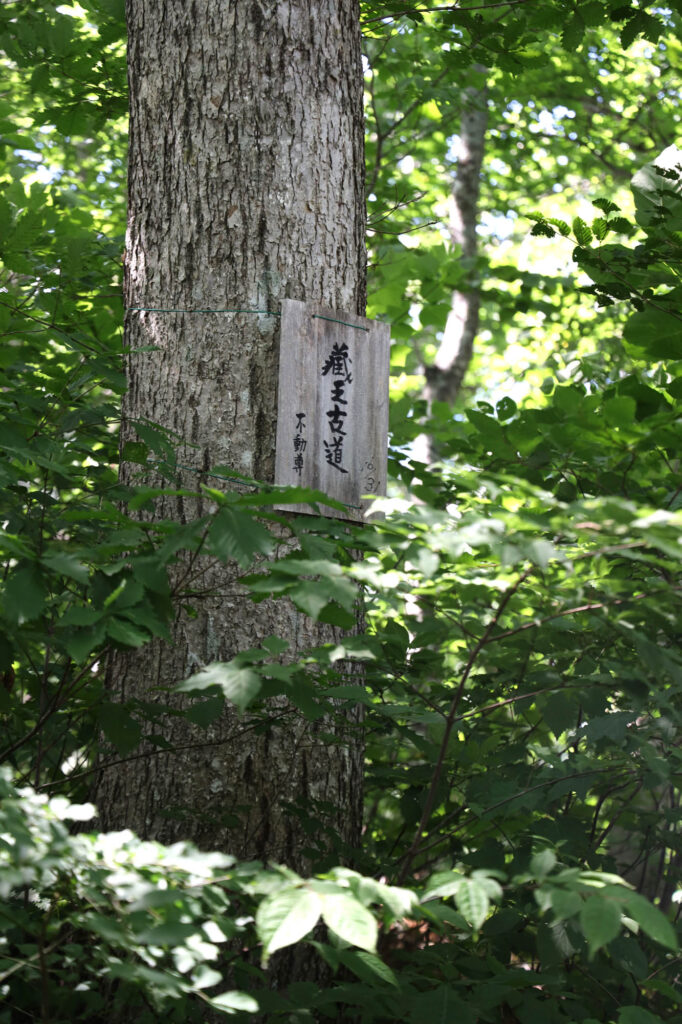
Zao Kodo signage in the mountains. Photo by Mayu Kanamori
At quarter to three, I drove 7.5 kms southeast to the Zao-machi Public Library. As soon as I walked into the Library, I saw a collection of old souvenir postcards from Togatta Onsen and photographs of mountain climbers, pilgrims and those who took part in the opening of the Echo Line on display behind glass.
The bookcase that housed their Zao collection was immediately to the left of the entrance, followed by their Miyagi collection. I saw photocopies of old booklets about the Togatta Onsen, about lodgings and the properties of the hot springs itself. There were thirteen poetry books, so I sat down to look through them. I photocopied two poems, one called Aoso no Yama by Endo Tadashi from his collection Shima Aoki Chizu (Hiiragi Shobo, 2016) and Aoso-san by Yasobe Tokio from his collection Yukuefumei no Kajintachi (Shigaku-sha, 1991).
I stopped by a roadside stall selling peaches. I bought four for Martin, who stayed at the studio writing. I returned to Togatta at 6pm.
We had a bath at Kami-no-yu, then ate dinner at another izakaya called Banya. The owner was born in Togatta and inherited the business three years ago from his mother-in-law.
We turned the lights out at 9:30pm.
Day 4
13 July 2023 Thursday
Sunny
Top of 29
After breakfast we drove the 20km road of Zao Echo Line, on prefectural road 12 to the top of Katta-dake to pay respects to the Kattamine Shrine Hongu and view the crater, called Okama (‘the honorary Cauldron’). There were high winds, and by the time we reached the Daikokuten at 1450 meters with 308 more meters to reach the top, clouds were forming, which turned to heavy fog by the time we arrived at the toll gates of the Zao High Line.
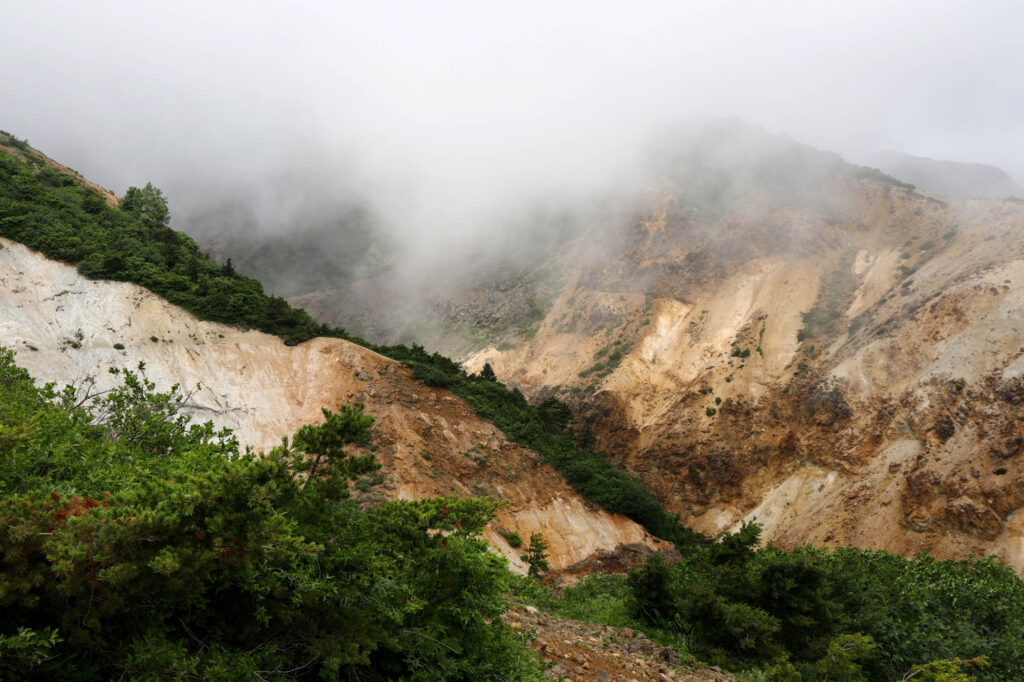
View from Daikokuten. Photo by Mayu Kanamori
The man at the toll gates asked if it was ok (for us to pay), considering the bad weather. We paid our 500 yen and took our chances. We got as far as the Zao Sancho Rest House but decided not to walk to the shrine and crater because of the cold strong wind; we would return on a better day.
On the way back we paid respects at Zao-dera temple, which included mizuko jizo for deceased children and babies, born and unborn, the war dead from Natori, Iwanuma and Sumida cities, a resting place for those without families to bury them in a family grave, and for the seven high school students and two teachers from Sendai, who froze to death because of a sudden snow storm whilst on a school hiking trip in October of 1918.
There were also protecting jizo for a long and healthy life untouched by disasters, jizo who take away the sufferings of life, and twelve different bodhisattvas of protection, one for each animal on the Chinese zodiac; also, a statue of Lord Enma, who judges the wrong doings of people during their lifetime.

Mizuko jizo at Zao-dera temple. Photo by Martin Edmond
After returning to Togatta, we bought bread for lunch at the bakery run by Klaus Christian (Chris) in the Zao Patio complex. Chris is originally from Munich, and lived in Christchurch, New Zealand for a decade before the earthquake, then in Fukuoka, then back in Christchurch, and now in Togatta for the last three years.
In the same Zao Patio complex, we bought an antique fan from Watanabe-san at E-link for 3000 yen, and he gave us the two poems he wrote for our residency project.
We spent the rest of the afternoon at our respective desks, writing and researching. At 3 pm, Satoh-san’s wife, Satoh Kyoko (46) came with two custard puddings made with local ingredients from Zaodo. Satoh Kyoko-san makes jewellery using kokeshi and works as a caretaker for the local public hall.
We went to Kami-no-yu for an early bath, and at 7pm, we went to Satoh-san’s house, which is also a Taiwanese teahouse called Manyocha and a record company called Manyaocya Records. He prepared tempeh nasi goreng with homemade tempeh which he made with Intan. Other than Satoh-san, Intan, Martin and I, there were two other guests, Kinose Chiaki-san, who runs the Mori no Bijutsukan with organic fabric dying and weaving studio, arts and workshop space, agricultural resort and a book cafe on an old school site in Kawasaki-machi, and Satoh Masafumi-san, who is an organic farmer and philosopher involved with the Mori no Bijutsukan.
We turned off our lights at 9:30pm.
DAY 5
14 July 2023 Friday
Sunny, then cloudy
Top of 29
After breakfast in the studio with bread from Bring, we both worked at our respective desks. I wrote my diary, sorted photographs and poems, and worked as an editor of our publication as part of our residency project. Martin wrote poetry. Then he went for a walk up to the Yugami-jinja Shrine.
The origin of the Yugami-jinja Shrine dates back to the 8th year of the Genroku era (1695), when Onuma Kyubei, a hot-spring guardian at the time, took the initiative and together with local people, erected a stone monument to Zao Gongen on the hillside of Gongen Mountain. The deity is Zao Yugami or Zao’s hot water god.
We had lunch 1:30 pm at Hanamizuki, then mostly continued to work at our desks other than when I went to buy tofu at Hasegawa-ya, bread at Bring and vegetables at Ono Shoten.
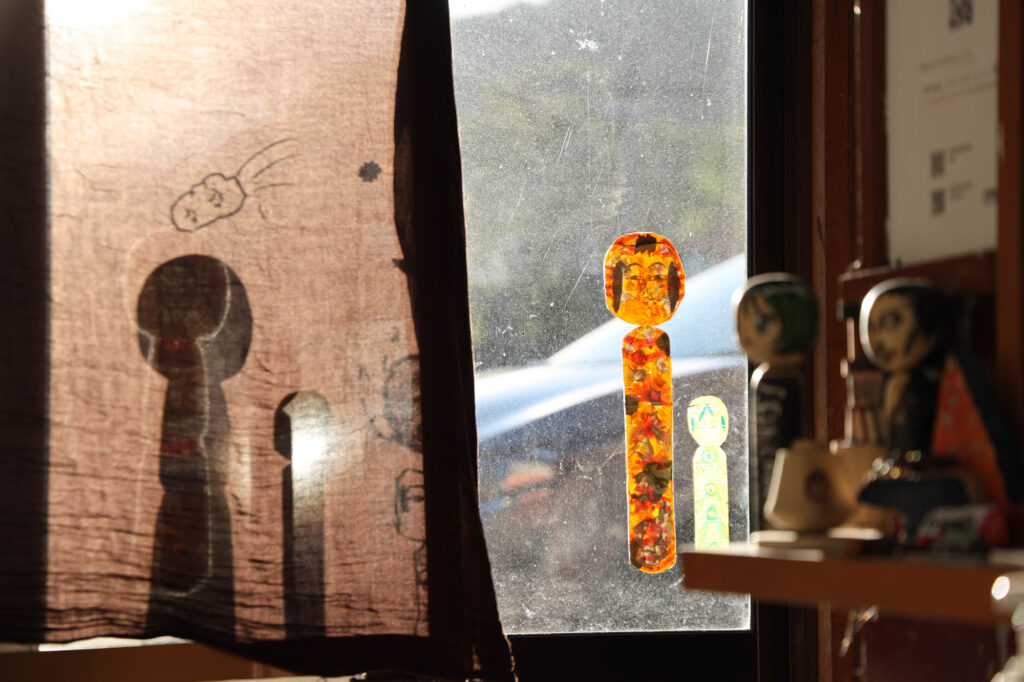
Afternoon light through Togatta Maruyoshi Artist Residence window. Photo by Mayu Kanamori
At 8:30pm Satoh Kyoko-san came to the studio with two poems she wrote for our residency project. She told us she was going to Tokyo because she had an exhibition there. She showed us photographs of necklaces and earrings with miniature kokeshi made by a traditional kokeshi maker as well as small balls made with fabric she had dyed herself with indigo.
We turned off our light at 9:30 pm.
DAY 6
15 July 2023 Saturday
Rain
Top of 24
Intan arrived at 8:30 am with her washing, which we started, had breakfast with the bread from Bring, then left the studio for Intan to work in. We crossed the Kokeshi-bashi Bridge and drove south on National Highway 457 and stopped at the Zao Dairy Centre and bought cheese at the Cheese Cabin and vegetables at the vegetable shop.
We missed the turn off to Zao Fox Village, and continued driving on route 457, circling Aoso-san Mountain on its western foothills. We turned south just after Kosute-kawa River, then west onto Prefectural Road 254. Once the road swerved north, route 254 was lined with different types and colours of hydrangeas in full bloom on both sides of the road. We reached the Zao Fox Village at 11:45.
The Zao Fox Village had 130 foxes of 6 varieties roaming in a 10,000 square meter enclosure with native trees, rocks, wooden structures they can climb on or sleep in, fox statues and red torii gates, much like the Inari shrines. The newborn foxes were separated in group cages. There were also rabbits, ponies, and goats.
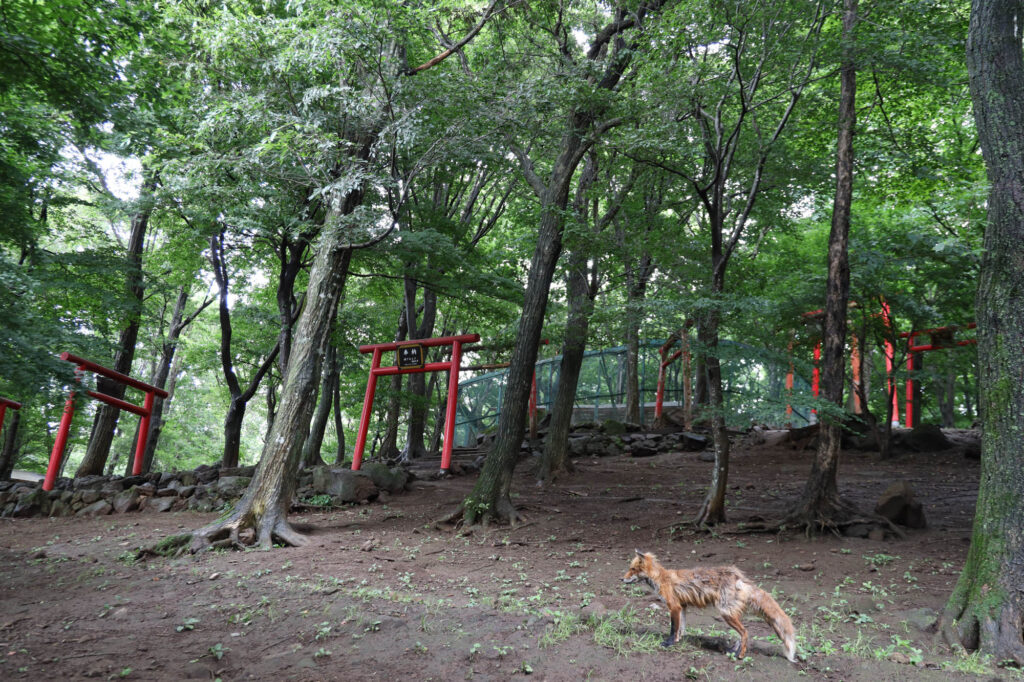
A fox at the Zao Fox Village. Photo by Mayu Kanamori
Afterwards, we drove back south on route 264, but instead of returning the way we came, we turned off towards Kamasaki Onsen, and followed the Yu-kawa River until we were back on route 457. We then went in the opposite direction on 457 to the one we had come on and took the Sennan Kouiki Nodo Cosmos Line along the eastern foothills of Aoso-san.
Something went wrong on our navigator, which led us to take another wrong turn off the Cosmos Line, and there we found signage indicating we were at the Gangyoji Remains. Gangyoji Remains are from the late Jomon period (c. 14,000 – 300 BC) and were villages built on the eastern foothills of Aoso-san. There are other similar sites in the area. The figurines collected at the Gangyoji Remains are unusual because most other Jomon period clay figurines are in an upright posture, but there are ones found on this site which are sitting down with their knees bent and their hands on their knees. It is thought that some of these figurines show women giving birth.
After we returned to the Cosmos Line, we went passed another site of Jomon archeological site, the Kajizawa Remains. A survey in 2007 and 2008 uncovered the remains of building pillars and pottery from the middle of the late Jomon period (approximately 2,700 to 2,600 years ago). The remains consisted of 4 to 5 buildings arranged in an arc, and the structure had been rebuilt at least eight times. Pottery were buried in holes dug in the ground which are thought to be graves for infants and foetuses.
A reburial site from the early Yayoi period (400 BC to 300 AD) were also found there. The reburial method was also used in the northern Kanto areas and in Fukushima Prefecture; the remains are buried, then excavated later, the bones collected, put into a jar, and reburied.
We drove around Aoso-san Mountain and returned to Togatta via Prefectural Road 12 at 1:30 pm. We had lunch at Zao Boo Burger. Martin went back to the studio, and I went to the Zao-machi Public Library again. On this day I photocopied two poems that included Zao: Inori by Sakuma Akira in his collection Zao no Uta (Tanka Shinbunsha 1988), Zao no Yama by Otsuki Hirashichi in his collection Sarasoju (Tohoku Araragi Koriyama 1978); two untitled tanka poems mentioning Zao by Matsuyuki Akira in Zao Tankasha Second Collection (Zao Tankasha, 2019) and ten tanka poems by Kimura Yoko (who I met on the first day in Togatta) from the same Zao Tankasha collection.
I returned to the studio at 5:15 pm. We had dinner with the produce purchased earlier in the day.
Martin turned off his light at 9 pm. I wrote this diary and turned in at 11 pm.
Day 7
16 July 2023 Sunday
Sunny
Top of 35
After breakfast with bread from Bring, I left the studio at 9 am to spend the day in Shiroishi with Adachi Mayumi-san (59), who was introduced to me by Reiko White from Sydney. Mayumi-san was born in Shiroishi, had a career in early education and is now working at the Shiroishi City Council Office in their Education Department.
I left Togatta along Prefectural Road 12, turning south onto the Cosmos Line, then onto the Shiroishi Bypass, then onto another part of Prefectural Road 12 and arrived at the Shiroishi-jo Joka Hiroba Car Park in less than 30 minutes. I realised after I arrived that I had mistaken the meeting time: I thought it was 10 am, when in fact it was 10:30 am. I drove around Shiroishi Station twice, then parked the car to have a closer look at the area around the railway station.
I met with Mayumi-san at 10:30 am, got into her car and she drove the half kilometer to Okazaki Ryokan at Watari-machi. We met the owner of the ryokan, Okazaki Yoshie (83) and her son Toshiaki-san, who works with Mayumi-san at the Shiroishi City Council. I explained to Okazaki-san that I am the daughter of Kanamori Kaoru, who is the son of Kanamori Saburo who was adopted by the Okazaki family, and that I remember visiting the Okazaki Ryokan with my grandmother Kanamori Kuni when I was young. I did not remember how old I was at the time, but probably five or even younger.
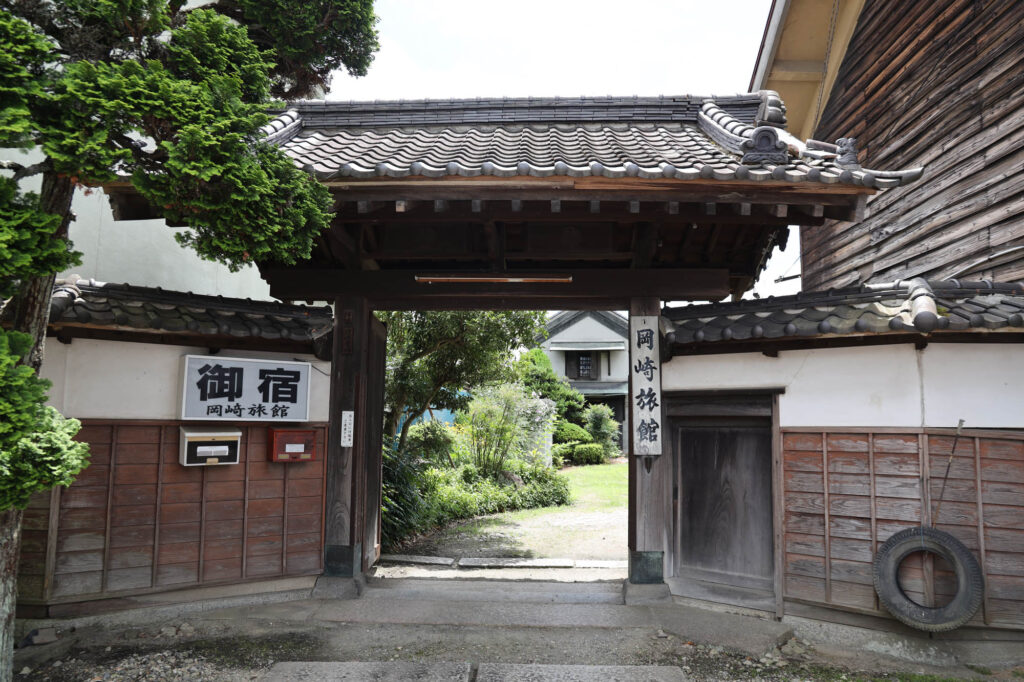
Okazaki Ryokan entrance at Watarimachi in Shiroishi. Photo by Mayu Kanamori
When I said that I remembered the Okazaki Ryokan standing on the street in front of the train station, Yoshie-san explained that there was an Okazaki Ryokan Honkan (main building) where the current Sennan Bank is situated, run by another branch of the family, and that her place was the Okazaki Ryoka Bekkan (annex). She said that the Okazaki Ryokan Honkan had closed some time ago.
Yoshie-san said that she remembered my grandfather Saburo being in her house eating eel with his sister, who was Yoshie-san’s mother-in-law. She said she does not remember what they were discussing. She did not get involved, because she was the ‘yome’ or daughter-in-law of the family.
Toshiaki-san showed me a family tree spanning nine generations, starting from the first generation born in 1820, and created in 1994. My grandfather Kanamori Saburo was adopted by Okazaki Sataro (5th generation) and his wife Yasu, who was the fourth daughter of Kanamori Hirokichi from Shiogama. Saburo’s biological parents were Kanamori Kyuzo and his wife Mie. Kyuzo was Yasu’s brother.
The first three generations on the family tree are the lineage of Yone, the wife of Okazaki Sazou. Yoshie-san explained that the first Okazaki came from Nagoya as a roof tiler and was working in Kesenuma. He came to Shiroishi and became involved in the wholesale fish business, then the inn business. Yoshie-san also remembered that the family members stood on the platforms as the trains came in and sold ekiben bentos or station meals in boxes.
Before we left, Yoshie-san gave me packages of umen noodles, a speciality of Shiroishi and a Shiroishi kokeshi doll.
Mayumi-san and I left the Okazaki ryokan about 11:45 am, and visited Hekisuien, which houses a tearoom and Noh theatre. We met Toshiaki-san’s wife, who was working in reception for a tea ceremony meeting. Mayumi-san and I attended the tea ceremony, then Mayumi-san took me to a restaurant near her home to try Shiroishi umen noodles.
At 2 pm we went to the Suruma-yashiki, an old Japanese style mansion built during the Meiji (1868-1912) and Taisho (1912-26) eras for the Watanabe merchant family, which was donated to the City of Shiroishi. It is an events and community centre near the train station and we went there to meet with Nishida Tomo-san, a poet and author of poet Suzuki Umeko’s (1898-1973) biography, Suzuki Umeko no Shi to Shogai (Doyo Bijutsu Shuppan Hanbai, 2020). Although Suzuki Umeko published three poetry collections and was known to leading poets of her time, she was better remembered as the proprietress of Daimi, a merchant family, and her poetry forgotten until Nishida Tomo published her biography.
I explained our residency project to Nishida-san, and what appeared to be a dearth of poetry places in the local area and asked her if she knew of any poets who wrote about Togatta Onsen or if she knew of any poetry, song or haiku monuments in Togatta. She thought there should be, as most onsen areas value literary visitors, and said she would see if she could find out or at least point me in a direction where I could find them.
At Suruma-yashiki we also met Tatsuta Fudiko-san, the manager of Shirosihi Machizukuri and Abe Keiji-san, who is working towards the preservation of the traditional craft of Shiroishi Washi paper making, and manages the Shiroishi Washi paper group, Kurafuto. Shirosihi Machizukuri looks after the Surumaya-shiki, Kurafuto and a carpark near the train station.
After our meeting, Mayumi-san took me to see the stone poetry monument with a poem written by Horiguchi Daigaku (1892 – 1981) for Suzuki Umeko, called Kokeshi, outside the White Cube, a town facility with a concert hall and sports centre. Horiguchi Daigaku was a poet and translator, who is known for introducing French surrealism to Japanese poetry and for translating over sixty-six French poets’ works into Japanese.
Mayumi-san took me back to my car and gave me bread from her favourite bakery and Zao sake to take back for Martin. I asked her about Aoso-san, the mountain, and she said that as children they all thought it was a landing place for UFOs. Before I returned to Togatta, I went back to the road by Shiroishi train station and photographed the Sennan Bank where the Okazaki Ryokan Honkan used to be.
I left Shiroishi at 4:15 and drove back to Togatta following National Highway 4 to Zao-machi, then on to Prefectural Road 12, and returned to the studio before 5pm.
At 6 pm Martin and I went to buy takeaways at Satoh-san’s home Taiwanese teahouse and record company, Manyaocya Records, where Intan was having a pop-up exhibition and serving homemade tempeh nasi goreng. Other than Intan and Satoh-san, there were three other couples. One couple were Intan’s friends who were visiting for the day, and two other locals, including Chiaki-san and Masafumi-san from the other evening, and another with two children, to whom we were not introduced. Masafumi-san gave us some of his home-grown organic potatoes and kale.
It was too late for the Kami-no-yu, so we soaked our feet in the ashiyu outside, and turned off the lights at 8:30 pm.
Day 8
17 July 2023 Monday
Sunny
Top of 35
After breakfast we worked at our respective desks writing until Intan’s friends Terazaki Keitaro and Ito Rina from Tokyo arrived at 10 am. Intan came to the studio too, and the three went to Sendai. Martin and I drove over the Kokeshi-bashi Bridge on Route 457, and soon turned right into the Kokeshi maker’s village. The village’s sacred site was through a torii gate, and after climbing the stairs to the top, we paid our respects at four shrines: to Inari, Furumine, Yamagami and Koretaka.
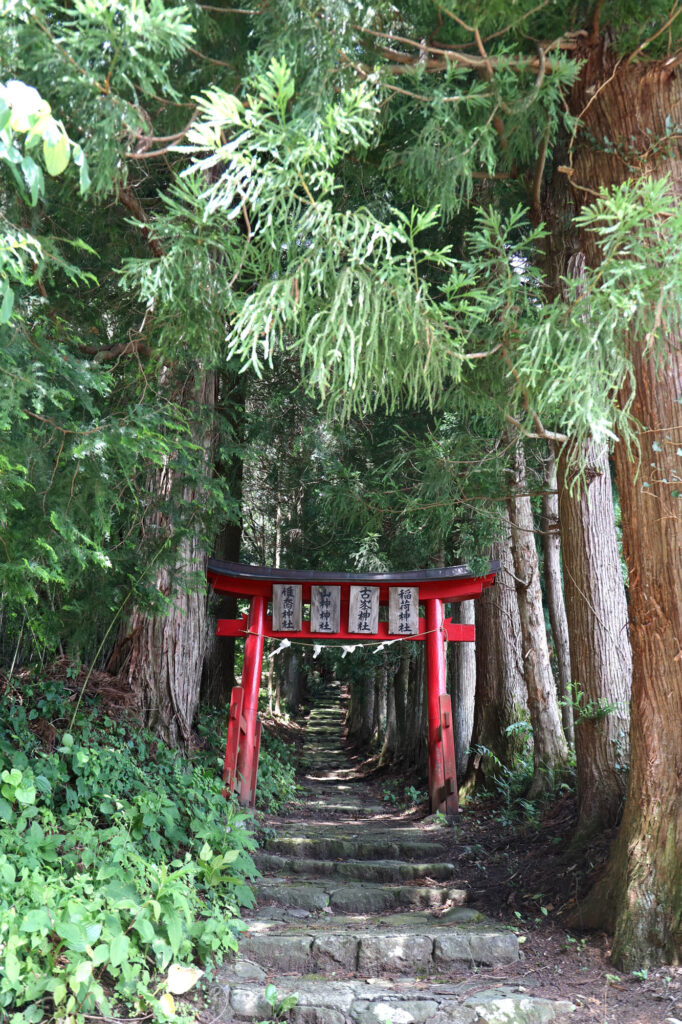
Torii gates to the four shrines at kokeshi maker’s village. Photo by Mayu Kanamori
We drove slowly around the area twice, knowing that this was the Shinchi Iseki area, where there have been archaeological discoveries, for instance just south of this shrine, from Kodai times, which in Japan usually means from the beginning of Nara era (CE 710-794) to the end of Heian era (CE 794-1185). We then drove east and turned off Route 457 on to a local road that looped south and took us back, eventually, onto Route 457. Here we passed through areas where there have been finds from the Nanokahara Iseki, where they found early Jomon period (c. 14,000-300 BCE).
We then backtracked on Route 457, over the Kokeshi-bashi Bridge again, passed our studio, turned east onto Route 12, then south onto the Cosmos Line, then turned east at the first road sign that read: to Aoso-yama, although this mountain is locally often called Aoso-san. This was the same road we mistakenly took the other day and found the Gangyoji Iseki.
There were farms along this road. One farmhouse had a collection of a dozen stones with engraved names of shrines, deities and jizos by the home. On the southern corner of the second cross way along this road is a rock about two meters wide and one meter high, with engravings that read: Bato Kannon (Horse-head bodhittsava), Suiun-jinja (Water-cloud shrine) and another name of a shrine with a deity I could not construe.
Turning south at this corner, we drove up Aoso-san. Aoso means blue hemp and san means mountain. During the Nara and Heian times, Aoso-san was called Okatta-dake and is said to have been worshipped by villagers on its foothills as the mountain that protected them from the eruption of Katta-dake mountain in the present day Zao Mountain Ranges.
The map showed Yakushi-do Temple halfway up Aoso-san but we were unable to find it. There was logging as well as construction activity on Aoso-san. The road eventually started to run down the hill and we came out on the other side through the village of Kitaharao on the western foothills of the mountain.
Kitaharao is a dairy farming village, pioneered by people who once lived in what is now the Republic of Palau in the South Pacific, and were resettled here after World War II. Palau had become a Japanese colony in 1920, as part of the South Seas Mandate, which was a League of Nations initiative granting German colonies in the South Pacific to the Empire of Japan following the war.

Collection of stone monuments engraved with names of shrines, deities and jizos near the Gangyoji Iseki. Aoso-san Mountain is in the background. Photo by Mayu Kanamori

View of Zao ranges from Nakanohara Iseki. Photo by Mayu Kanamori
Where the road through Aoso-san met Route 457 on the western foothills, there were three monuments. One for the spirit of pioneers, another for the spirit of cows, and one commemorating the visit of the then Japanese Emperor Akihito and Empress Michiko in 2015.
We drove back north on Route 457 and stopped for lunch at the Zao Dairy Centre and also bought vegetables. After lunch we drove up the Zao Echo Line again to see the komakusa flowers but couldn’t find a viewing platform.
We returned to our studio at 3 pm and worked. At 4:30 pm I went to buy tofu at Hasegawa-ya again. We went to Kamino-yu at 6:30 pm, had dinner at the studio, and turned out our lights at 9 pm.
Day 9
18 July 2023 Tuesday
Cloudy
Top of 32
I woke up to two emails from poet Nishida Tomo-san. In her first email, time stamped at 00:29 am, she asked whether I had seen the stone haiku monument at the park by Shiroishi Castle with Matsuo Basho’s haiku about kamiko (paper kimono), and if the word kamiko was written in hiragana or kanji. In the same email she said that when she stated that there would be poetry, song or haiku monuments in Togatta, she had a particular poet, Izumi Yukihisa (1936-1972) in mind, but upon checking, she found she had been mistaken, and that there appears not to be such a monument in Togatta.
She said that the poet Izumi Yukihisa, who was from Palau, settled in Zao after the war, working as a farmer as well as helping a kokeshi maker and driving a taxi in town. When he was 36 years old, he was found dead near the Fudomyo Waterfall.
Her second email was a clarification: although Matsuo Basho’s poem mentioning kamiko is engraved on a stone monument near Shiroishi Castle, he had not written the haiku in Shiroishi itself, but in Tokyo, a few days before he departed on his trip up north. She said, however, that kamiko is made of Shiroishi washi paper, and is thus a Shiroishi speciality.
At 8:30 am I walked to the Togatta Primary School. After meeting the school principal, Otsuki Yu-sensei and obtaining permission to take photographs of the students attending Intan’s workshops and to publish them, I joined Intan, Satoh-san, Nagai-san and the 17 students of Class 1 of the 5th Grade. Their teacher, an alumni and an observer from the Miyagi Prefectural Office’s Cultural Department were also present. Intan used an AI translator to lead the children to make and decorate tote bags from used T-shirts.

Intan and Satoh-san at Togatta Primary School. Photo by Mayu Kanamori
At 11 am, Nagai-san, Martin and I drove to Shiroishi in two cars using the Cosmos Line. We had a lunch of umen noodles at Yamabuki-tei, then went to the Masuoka Park by Shiroishi Castle and looked for Basho’s haiku monument. We were unable to find it at first, so we visited the castle and the Shiroishi Historical Museum. After the museum visit, we went back to the park and Nagai-san found it along the walking path northwest of the castle towards the car park. The word kamiko was in hiragana.
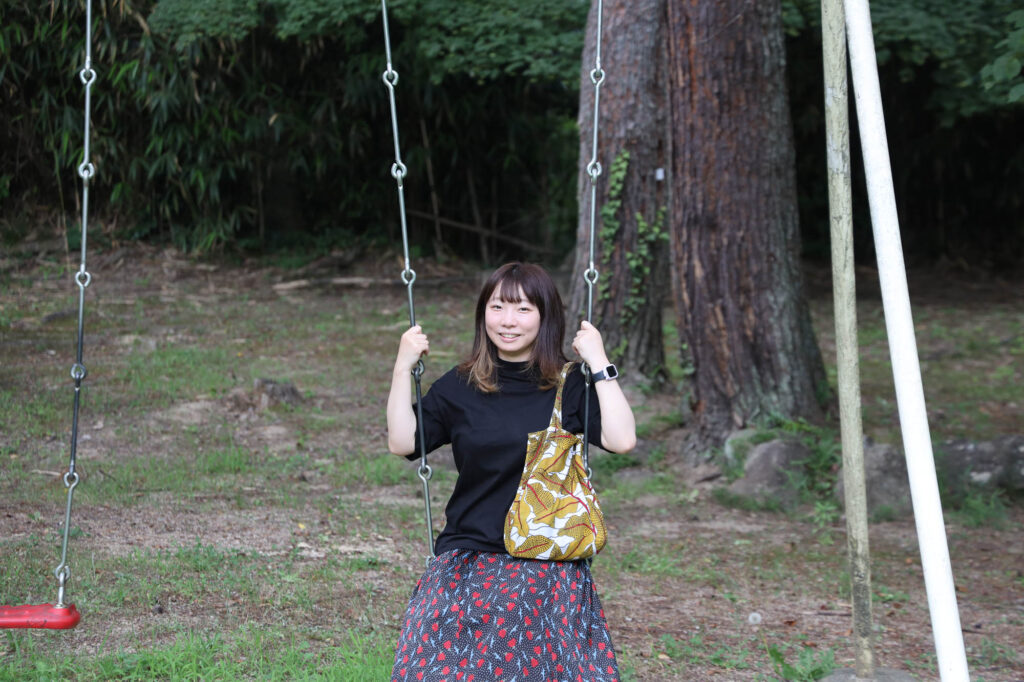
Nagai-san at Masuoka Park by Shiroishi Castle. Photo by Mayu Kanamori
We returned to the studio about 4 pm. We worked at our respective desks until 6:30 pm. Kyoko-san came to visit to let us know she had returned from Tokyo. When we told her about the poet Izumi Yukihisa, she told us about another poet called Ogata Kamenosuke from Odaihara, the town next door, who also died young.
I had a bath at Kamino-yu, then we walked to an izakaya called Tanuki. We sat at the same table with two tourists, one from Tokyo and his friend from Sendai. The proprietor of Tanuki remembered Martin from earlier when he gave way to his car at a crossing. He gave us corn to take back to the studio.
When we arrived back at the studio, Intan was waiting, because she had left her phone inside Satoh-san’s house, and that meant that she was not able to get back into his house. It was her last night in Togatta, she chatted with us for a while before leaving.
We turned out lights out about 9:30 pm.
Day 10
19 July 2023 Wednesday
Rainy
Top of 26
Intan left early in the morning from the Togatta Onsen bus stop for Sendai. She said that she was going to Aomori, then Morioka, then to Tokyo, where she was exhibiting her work, then to the Kansai region before returning to Jakarta.

Togatta Onsen bus stop. Photo by Mayu Kanamori
Martin and I stayed in our studio working until lunch time when Chris from Bring came. We walked to Enso to have lunch together. Chris said that although he had studied and enjoyed reading literature when growing up, he had never understood poetry because he could not feel the poem. However recently, as part of his learning to read Japanese kanji characters, he has been studying its origins and its references through readings of old Chinese poems and found that these poems resonated with him.

Klaus Christian (Chris) at bakery Bring. Photo by Mayu Kanamori
***
It is 4:35 pm on 19th of July 2023.
I am ending my diary today, and now. Although we are in Togatta for another four days, I must now put the diary writing aside and use the rest of the time to translate poems, choose photographs and tie up other loose ends of this project.
- M.K.
Postscript on MK Diary
The MK Diary was inspired by the Sora Tabi Nikki (曾良旅日記), a memorandum by Kawai Sora of his travels with Matsuo Basho on the journey to Oku-shu and Hoku-riku, which resulted in Basho’s famous haibun Oku no Hosomichi. Kawai Sora was a poet, a student of Basho’s, and arguably a spy. He kept a meticulous record of places visited and the distances between them. In comparison to Oku no Hosomichi , there are no emotional or poetic sentences in his diary.He also prepared the Meishō Memorandum or the Utamakura Memorandum, where he listed the utamakura of places they were due to pass through, then added notes to it along the way.
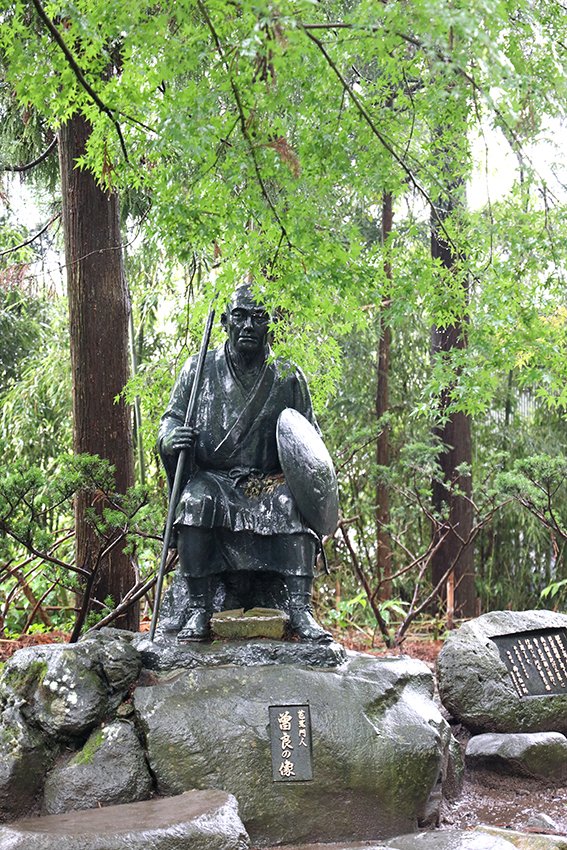
Statue of Kawai Sora at Yamadera, Yamagata Prefecture. Photo by Mayu Kanamori
I finished writing the MK Diary on the tenth day of the residency (19 July, 2023), but many things continued to happen on the remaining four days of our time in Togatta, including visiting Aoso-san again, this time guided by Endo Yuichiro-san, who showed us the way to Yakushi-do Temple. On the way back, he also showed us the nearly one hundred year old Iboiwa circular diversion structure, engineered by his ancestors, a water mechanism that evenly distributes agricultural water from the Sumi-kawa River, originating in the Zao Ranges, to 850 hectares over three towns in the region; it is still functioning today.
The third trip to the Zao-machi Public Library revealed that they did not hold any works by or about Kitaharao poet Izumi Yukihisa (泉行尚 ), although the Miyagi Prefectural Library in Sendai holds the May 2003 issue of the magazine Shiroi Kuni no Uta (Tohoku Electric Company Koho), which has an article about him, Furusato no Bungakusha: Izumi Yukihisa as does the December 1989 issue of the magazine Reiro (Shoshiki Sessha), Izumi Yukihisa Sakuhinshu, both written by Miyagi poet, Yamato Katsuko. A search on the internet tells me that there is also an academic paper by the same author, Zao ni Iki Zao ni Shinda Shijin. The Library in Zao-machi did not have collections by the poet Ogata Kamenosuke either but the Ogawara-machi Library does.
Although there were some things I would have liked to have done, such as going to Sendai or to Ogawara-machi Libries, I made the choice to pause the research and take the time to record what I have learned for others to read in case they may wish to add to the Togatta utamakura. And Satoh Kyoko-san came to our studio on Friday 21st of July to lend me a copy Ogata Kamenosuke Shishu (poetry collection) (Gendai Shibunko, 1975). I will stop writing now so that I have time to read some of it.
Please feel free to contact me or my collaborators.
Mayu: https://mayu.com.au/contacts/
Martin: https://mjedmo.wordpress.com/
Chie: https://www.tramindo.com.au/contact/
